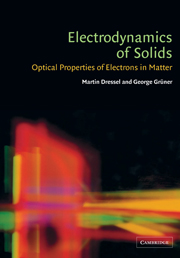PART THREE - EXPERIMENTS
Published online by Cambridge University Press: 20 May 2010
Summary
Introductory remarks
The theoretical concepts of metals, semiconductors, and the various broken symmetry states were developed in Part 1. Our objective in this part is to subject these theories to test by looking at some examples, and thus to check the validity of the assumptions which lie behind the theories and to extract some important parameters which can be compared with results obtained by utilizing other methods.
We first focus our attention on simple metals and simple semiconductors, on which experiments have been conducted since the early days of solid state physics. Perhaps not too surprisingly the comparison between theory and experiment is satisfactory, with the differences attributed to complexities associated with the electron states of solids which, although important, will not be treated here. We also discuss topics of current interest, materials where electron–electron, electron–phonon interactions and/or disorder are important. These interactions fundamentally change the character of the electronic states – and consequently the optical properties. These topics also indicate some general trends of condensed matter physics.
The discussion of metals and semiconductors is followed by the review of optical experiments on various broken symmetry ground states. Examples involving the BCS superconducting state are followed by observations on materials where the conditions of the weak coupling BCS approach are not adequate, and we also describe the current experimental state of affairs on materials with charge or spin density wave ground states.
Information
- Type
- Chapter
- Information
- Electrodynamics of SolidsOptical Properties of Electrons in Matter, pp. 299 - 300Publisher: Cambridge University PressPrint publication year: 2002
